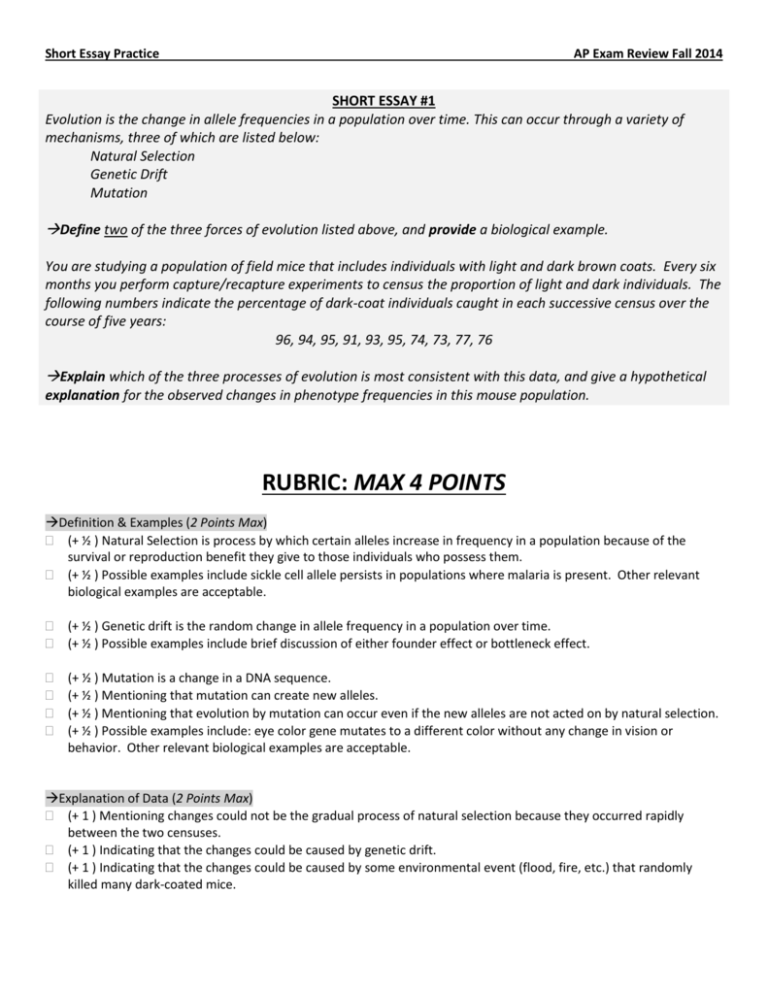rubric: max 4 points
advertisement

Short Essay Practice AP Exam Review Fall 2014 SHORT ESSAY #1 Evolution is the change in allele frequencies in a population over time. This can occur through a variety of mechanisms, three of which are listed below: Natural Selection Genetic Drift Mutation Define two of the three forces of evolution listed above, and provide a biological example. You are studying a population of field mice that includes individuals with light and dark brown coats. Every six months you perform capture/recapture experiments to census the proportion of light and dark individuals. The following numbers indicate the percentage of dark-coat individuals caught in each successive census over the course of five years: 96, 94, 95, 91, 93, 95, 74, 73, 77, 76 Explain which of the three processes of evolution is most consistent with this data, and give a hypothetical explanation for the observed changes in phenotype frequencies in this mouse population. RUBRIC: MAX 4 POINTS Definition & Examples (2 Points Max) (+ ½ ) Natural Selection is process by which certain alleles increase in frequency in a population because of the survival or reproduction benefit they give to those individuals who possess them. (+ ½ ) Possible examples include sickle cell allele persists in populations where malaria is present. Other relevant biological examples are acceptable. (+ ½ ) Genetic drift is the random change in allele frequency in a population over time. (+ ½ ) Possible examples include brief discussion of either founder effect or bottleneck effect. (+ ½ ) Mutation is a change in a DNA sequence. (+ ½ ) Mentioning that mutation can create new alleles. (+ ½ ) Mentioning that evolution by mutation can occur even if the new alleles are not acted on by natural selection. (+ ½ ) Possible examples include: eye color gene mutates to a different color without any change in vision or behavior. Other relevant biological examples are acceptable. Explanation of Data (2 Points Max) (+ 1 ) Mentioning changes could not be the gradual process of natural selection because they occurred rapidly between the two censuses. (+ 1 ) Indicating that the changes could be caused by genetic drift. (+ 1 ) Indicating that the changes could be caused by some environmental event (flood, fire, etc.) that randomly killed many dark-coated mice. SHORT ESSAY #2 Homeostasis, or the maintenance of a steady-state environment, is a characteristic of all living organisms. For two of the following physiological parameters, describe how homeostasis is maintained. Blood Glucose Levels Body Temperature Blood Calcium Levels Discuss how disruptions to the mechanisms that control blood glucose levels can have deleterious effects on the homeostasis of a particular organism of your choice. RUBRIC: MAX 4 POINTS Blood Glucose Levels (1.5 Points Max) (+ ½ ) Mentioning insulin/glucagon is released from pancreas. (+ ½ ) Mentioning insulin stimulates uptake of glucose from the blood to the liver. (+ ½ ) Mentioning insulin causes glucose to be stored as glycogen in the liver. (+ ½ ) Mentioning insulin signals body cells to take up glucose for energy use. (+ ½ ) Mentioning glucagon stimulates the liver to release glucose into the bloodstream. Body Temperature (1.5 Points Max) (+ ½ ) Describing how body insulation (hair, fat, feathers) reduces heat loss. (+ ½ ) Mentioning that vasodilation results in increased blood flow and increased heat loss. (+ ½ ) Mentioning that vasoconstriction results in decreased blood flow and decreased heat loss. (+ ½ ) Mentioning that sweating results in evaporative cooling. (+ ½ ) Mentioning that shivering generates energy. Blood Calcium Levels (1.5 Points Max) (+ ½ ) Mentioning that parathyroid hormone (PTH) is released by the parathyroid gland. (+ ½ ) Mentioning that PTH increases the amount of calcium in circulation. (+ ½ ) Mentioning that PTH causes release of calcium from bones. (+ ½ ) Mentioning that PTH leads to increased absorption of calcium by the intestines and kidneys. (+ ½ ) Mentioning that calcitonin is released by the thyroid gland. (+ ½ ) Mentioning that calcitonin decreases the amount of calcium in circulation. (+ ½ ) Mentioning that calcitonin promotes reabsorption of calcium by the bones. (+ ½ ) Mentioning that calcitonin leads to decreased absorption of calcium by the kidneys and intestines. Disruption to Homeostasis (1 Point Max) (+ 1) Appropriate discussion of diabetes mellitus. SHORT ESSAY #3 Membranes are vital to the transport of substances into and out of cells. Three important forms of cellular transport include: Active Transport Endocytosis/Exocytosis Facilitated Diffusion For each of the forms listed above, explain how the organization of the cell membrane functions in the movement of specific molecules across membranes. Explain the significance of each type of transport to a specific cell. RUBRIC: MAX 4 POINTS Active Transport (1.5 Points Max) (+ ½ ) Describing active transport as the movement of molecules against a gradient or in bulk across membranes, which require energy. (+ ½ ) Mentioning that it allows the cell to concentrate substances within the cell membrane. (+ ½ ) Mentioning that it is performed by protein pumps embedded within the membrane. (+ ½ ) Possible Example: sodium-potassium pump moves potassium into the cell and sodium out of the cell against steep gradients. Other relevant biological examples are acceptable. Endocytosis/Exocytosis (1.5 Points Max) (+ ½ ) Mentioning that endocytosis brings a substance into a cell by enclosing it within a membrane-created vesicle. (+ ½ ) Mentioning that the vesicle then fuses with lysosome containing hydrolytic enzymes. (+ ½ ) Possible Example: phagocytic white blood cells of the immune system engulf foreign invaders. Other relevant biological examples are acceptable. (+ ½ ) Mentioning that exocytosis expels waste substances for export by enclosing these substances in a vesicle that fuses with the membrane. (+ ½ ) Possible Examples: cells expelling waste or a pancreatic cell exporting insulin protein into the bloodstream. Other relevant biological examples are acceptable. Facilitated Diffusion (1.5 Points Max) (+ ½ ) Describing facilitated diffusion as the diffusion of particles with the assistance of membrane transport proteins. (+ ½ ) Mentioning that transport proteins are specific and have a binding site for the specific molecules of interest. (+ ½ ) Mentioning that it does not require energy. (+ ½ ) Possible Examples: osmosis occurs from hypotonic solution to a hypertonic solution across aquaporins. Other relevant biological examples are acceptable. SHORT ESSAY #4 The complete oxidation of a mole of glucose produces 686 kcal of free energy. The oxidation of a mole of glucose in a cell generates a maximum of 38 moles of ATP. Each mole of ATP stores about 7.3 kcal of energy. The efficiency of the ATP energy yield from the complete aerobic respiration of glucose is about 40 percent. Using the laws of thermodynamics, explain what happens to the rest of the energy. Describe how humans benefit from this energy loss. Discuss why hibernating animals possess an adaptation to reduce efficiency of cellular respiration even further. RUBRIC: MAX 4 POINTS Loss of Energy (2 Points Max) (+1) Mentioning that energy cannot be created or destroyed but only transformed from one form to another (first law of thermodynamics). (+1) Mentioning that every energy transformation results in some energy loss as heat (second law of thermodynamics). Benefits from Loss of Energy (1 Point Max) (+1) Mentioning that humans use some of the heat to maintain body temperature. Adaptation of Hibernating Animals (1 Point Max) (+ ½ ) Mentioning that hibernating animals don’t need a lot of ATP because they are inactive. (+ ½ ) Mentioning that hibernating animals must still maintain internal body heat. (+ ½ ) Mentioning that lower efficiency means heat generation without much ATP being produced. SHORT ESSAY #5 Surface area is an important concept in biology. Explain how surface area plays a critical role in the digestive system of animals. RUBRIC: MAX 3 POINTS SA and the Small Intestine (3 Points Max) (+1) Mentioning that the majority of absorption occurs in small intestine. (+1) Mentioning that numerous folds and ridges increase surface area. (+1) Mentioning that villi and microvilli increase surface area. (+1) Mentioning that large surface area leads to greater absorption of nutrients. SHORT ESSAY #6 The following table includes data from scan samples conducted on a fictional mammal called a googabear every 10 minutes over the course of 42 hours. At each scan, it was noted whether the googabear was active or inactive. The percentage of active (feeding, moving, engaging in social behavior) and inactive (resting or sleeping) scans recorded for each time period are shown in the table below. Time % Active % Inactive 600-1200 83 17 1200-1800 75 25 1800-2400 22 88 0000-600 5 95 600-1200 93 7 1200-1800 89 11 1800-2400 15 85 Describe the pattern of activity for the googabear and discuss possible reasons for this pattern. RUBRIC: MAX 4 POINTS Interpretation of Data (4 Points Max) (+1) Mentioning that googabears are more active from 6am until 6pm (during daylight hours). (+1) Mentioning that they decrease activity from 6pm to 6am (when it is dark). (+1) Mentioning that googabears’ food source is available during nighttime. (+1) Mentioning that googabear predators are nocturnal (out at night), so it is safest for googabears to remain hidden at night. (+1) Mentioning that googabears rely on collective heat at night (huddling); activity of huddled group is low. SHORT ESSAY #7 In Earth’s early history, the evolution of photosynthesis in simple cells occurred before the evolution of more complex cells. Briefly describe the significance of photosynthesis being present first. Discuss one piece of evidence that supports the theory that chloroplasts and mitochondria are evolved from prokaryotic cells. RUBRIC: MAX 4 POINTS Significance of Photosynthesis (3 Points Max) (+ ½ ) Mentioning that photosynthesis releases oxygen as a by-product. (+ ½ ) Mentioning that photosynthesis led to an increase in atmospheric oxygen. (+ ½ ) Mentioning that the presence of oxygen in the atmosphere allowed the evolution of cellular respiration. (+ ½ ) Mentioning that oxygen allowed ells to generate more energy and grow larger and more complex. (+ ½ ) Mentioning that the first photosynthetic cells were prokaryotic. (+ ½ ) Mentioning that eukaryotic cells could not evolve until there was a higher level of atmospheric oxygen. Evidence of Endosymbiosis (1 Point Max) (+1) Mentioning that chloroplasts and mitochondria have their own DNA. (+1) Mentioning that chloroplasts and mitochondria make their own ribosomes (similar in size to bacterial ribosomes). (+1) Mentioning that chloroplasts and mitochondrial DNA consist of a single, circular molecule (like that of bacterial DNA). (+1) Mentioning that chloroplasts and mitochondria replicate by a process similar to prokaryotes (binary fission). (+1) Mentioning that the inner membranes of both organelles have enzymes homologous to those found in prokaryotes. SHORT ESSAY #8 You are asked to estimate if a certain species of plant could live in a salt marsh. You collect the following data: Overall Ψ of the soil: -2.2 MPa Solution Concentration of Plant Cell Contents: 0.08 M (assume i=1, and 12◦C) Pressure Potential of Plant Cells: -1.2 MPa R = 0.00831 liter MPa/mole K Describe whether or not the plant could grow in this environment and explain your prediction. Justify your reasoning. RUBRIC: MAX 4 POINTS Description & Explanation (2 Points Max) (+1) Mentioning that the plant cell’s water potential (-1.39 MPa) is higher than that of the soil (-2.2 MPa). (+1) Mentioning that water would flow out of the plant cell (hypotonic) into soil (hypertonic) or from high Ψ to low Ψ. (+1) Mentioning that the plant cell would not survive (plasmolysis). Justification / Calculate Solute & Water Potential of Plant Cell (2 Points Max) (+1) calculate solute potential Ψs of plant cell = -0.189 MPa (must show work) (+1) use solute potential to calculate water potential Ψ of plant cell = -1.39 MPa (must show work)







